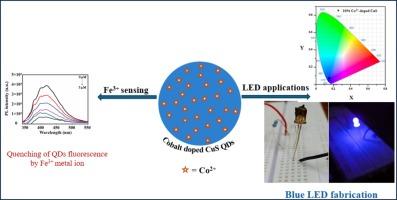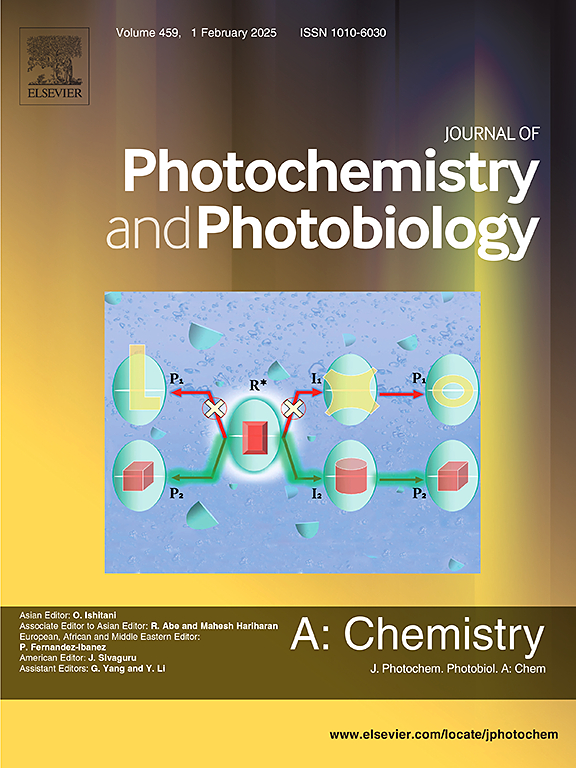明亮的蓝光发光掺钴 CuS 量子点:光物理研究和铁离子的选择性传感应用
IF 4.1
3区 化学
Q2 CHEMISTRY, PHYSICAL
Journal of Photochemistry and Photobiology A-chemistry
Pub Date : 2024-11-09
DOI:10.1016/j.jphotochem.2024.116137
引用次数: 0
摘要
近年来,表面功能化量子点(QDs)因其独特的光学特性,如强光致发光行为、高量子产率等,在 LED、光伏、传感、生物成像和生物医学等领域的各种应用中备受关注。然而,与镉基 QDs 相比,无毒 QDs 的光学特性较低,因此对研究人员来说,形成无毒 QDs 非常具有挑战性。半导体 QDs 中的掺杂现象是在宿主 QDs 中实现高光电特性的有效方法。我们介绍了一种以钴(Co2+)为掺杂剂的 CuS QDs 的低温胶体合成方法,该方法在室温下具有 30 天的超强稳定性。掺杂 Co2+ 的 CuS QDs 的光致发光(PL)特性在 420 纳米波长处呈现深蓝色发射,从而提高了光致发光量子产率,实现了优异的光学特性。由于合成的掺 Co2+ 的 CuS QDs 具有出色的 CIE 色度坐标、良好的 CCT 值和高色纯度,因此可广泛应用于 LED 中,并被证明是有用的蓝色荧光粉。合成的掺 Co2+ 的 CuS QDs 还可作为荧光探针检测铁离子 (Fe3+),其灵敏度高、选择性好、检测限 (LOD) 低、定量限 (LOQ) 低,分别为 (4.99 ± 0.12) μM 和 (16.67 ± 0.40) μM。本文章由计算机程序翻译,如有差异,请以英文原文为准。

Bright Blue-Light emitting cobalt doped CuS quantum dots: Photophysical studies and selective sensing application of ferric ion
Surface-functionalized quantum dots (QDs) have garnered significant attention in recent years for a variety of applications, including LEDs, photovoltaics, sensing, bioimaging and biomedical domains due to their distinct optical features such as strong photoluminescence behavior, high quantum yields etc. However, formation of nontoxic QDs is very challenging for the researchers because of their lower optical properties as compared to Cd based QDs. The phenomenon of doping in semiconductor QDs is an effective way to achieve high opto-electrical properties in the host QDs. We have presented a low temperature colloidal synthesis of CuS QDs using cobalt (Co2+) as a doping agent with an exceptional stability at room temperature for 30 days. The photoluminescence (PL) properties of Co2+-doped CuS QDs exhibit a deep-blue emission at 420 nm resulting in excellent optical property with an improvement of photoluminescence quantum yield. Due to remarkable CIE chromaticity coordinates, good CCT values, and high colour purity, the synthesized Co2+-doped CuS QDs could be used extensively in LEDs and prove to be useful as blue phosphors. The synthesized Co2+-doped CuS QDs also act as a fluorescence probe in the detection of ferric ion (Fe3+) with high sensitivity, good selectivity, a low limit of detection (LOD) and limit of quantification (LOQ), of (4.99 ± 0.12) μM and (16.67 ± 0.40) μM, respectively.
求助全文
通过发布文献求助,成功后即可免费获取论文全文。
去求助
来源期刊
CiteScore
7.90
自引率
7.00%
发文量
580
审稿时长
48 days
期刊介绍:
JPPA publishes the results of fundamental studies on all aspects of chemical phenomena induced by interactions between light and molecules/matter of all kinds.
All systems capable of being described at the molecular or integrated multimolecular level are appropriate for the journal. This includes all molecular chemical species as well as biomolecular, supramolecular, polymer and other macromolecular systems, as well as solid state photochemistry. In addition, the journal publishes studies of semiconductor and other photoactive organic and inorganic materials, photocatalysis (organic, inorganic, supramolecular and superconductor).
The scope includes condensed and gas phase photochemistry, as well as synchrotron radiation chemistry. A broad range of processes and techniques in photochemistry are covered such as light induced energy, electron and proton transfer; nonlinear photochemical behavior; mechanistic investigation of photochemical reactions and identification of the products of photochemical reactions; quantum yield determinations and measurements of rate constants for primary and secondary photochemical processes; steady-state and time-resolved emission, ultrafast spectroscopic methods, single molecule spectroscopy, time resolved X-ray diffraction, luminescence microscopy, and scattering spectroscopy applied to photochemistry. Papers in emerging and applied areas such as luminescent sensors, electroluminescence, solar energy conversion, atmospheric photochemistry, environmental remediation, and related photocatalytic chemistry are also welcome.

 求助内容:
求助内容: 应助结果提醒方式:
应助结果提醒方式:


